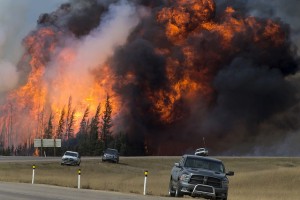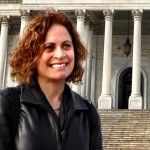
The images of a wildfire raging through subdivisions in Fort McMurray, Alberta last week were horrifying. Firefighters say the fire season is already well underway in Alaska, too, and they need citizens to do their part to keep their communities safe.
The Fort McMurray fire started during a spell of unusually warm weather. Suddenly, an entire city of 80,000 was on the run.
“It happened so fast people were told to leave immediately,” one newscast on CTV said. “Late reports say many buildings are burning. Whole neighborhoods have been destroyed. Even the downtown core is on fire … .”
Matanuska-Susitna Emergency Services Director Bill Gamble was far from Alberta, but he says that fire hit close to home.
“Absolutely it can happen here,” he said. “My first thoughts when I saw Fort McMurray go up in flames, it just took me right back to Miller’s Reach and the Sockeye fire here last year.”
The 1996 Miller’s Reach fire was said to be the most destructive in state history. It started near Big Lake, where Gamble at the time was the fire chief.
His department now is on full alert. Gamble says fire crews are responding to local reports of smoke, and checking on people burning brush to ensure they’re abiding by the safety limits of their burn permit.
“We’re out there not just waiting for calls to come to us, but we’re patrolling and trying to get ahead of the fires to keep them from getting out of control,” he said.
Much of Alaska is experiencing conditions similar to those that preceded the Fort McMurray fire. It’s been a dry spring following a low-snow winter, and now temperatures are much higher than normal.
“We’re going to see temperatures this weekend close to 80 degrees,” says Tom Kurth, fire program manager for the Alaska Division of Forestry, who is based in Fairbanks. “And if a wind accompanies that, we’d certainly have the conditions that will promote a large wildland fire.”
Among the communities at risk, his says, are those in the boreal forests north of the Alaska Range, the Mat-Su and Anchorage. Kurth’s eyes are also on the Kenai Peninsula, where he says there’s plenty of fuel for a wildfire.
“A lot of beetle-killed spruce now is down and instead of heavy forested land that we used to have, now there’s a lot of grassland out there that is really a very good fire carrier down there,” he said.
As Kurth prepares for the fire-fighting season, he’s lining up assets to help with a large-scale evacuation, and hoping one won’t be necessary.
Nationally, the federal government spends about $500 million a year to make land less fire-prone, by thinning trees, removing underbrush and building firebreaks. In Alaska, a few thousand acres have been treated in about five years. Kurth says it’s slow work, and there’s fierce competition for grants to fund it. Instead, much of the prevention effort is trained on YOU, the public.
Anchorage Fire Department forester John See says he takes every opportunity to educate homeowners, particularly in the most fire-prone areas of the city, like the Hillside and Eagle River.
“The message there is, ‘you chose to live in the wildland-urban interface so it’s up to you to provide for your structure and your family’s safety,’” he says.
This week, See has been doing property inspections, at the request of homeowners. He often finds room for improvement.
“We see lots of things like wood piles under decks. We see snowmachines right next to homes. Dead grass. Leaves that haven’t been raked away,” he said. “A number of homes still have wooden shake roofs.”
Like fire personnel around the state, See advises homeowners to clear a defensible space around their homes. He says a little bit of effort can make a home much more resistant to wildfire.
http://www.muni.org/Departments/Fire/Wildfire/Pages/AnchorageWildfireProgram.aspx
http://www.matsugov.us/news/how-to-prepare-for-a-wildfire
Liz Ruskin is the Washington, D.C., correspondent at Alaska Public Media. Reach her at lruskin@alaskapublic.org. Read more about Liz here.





